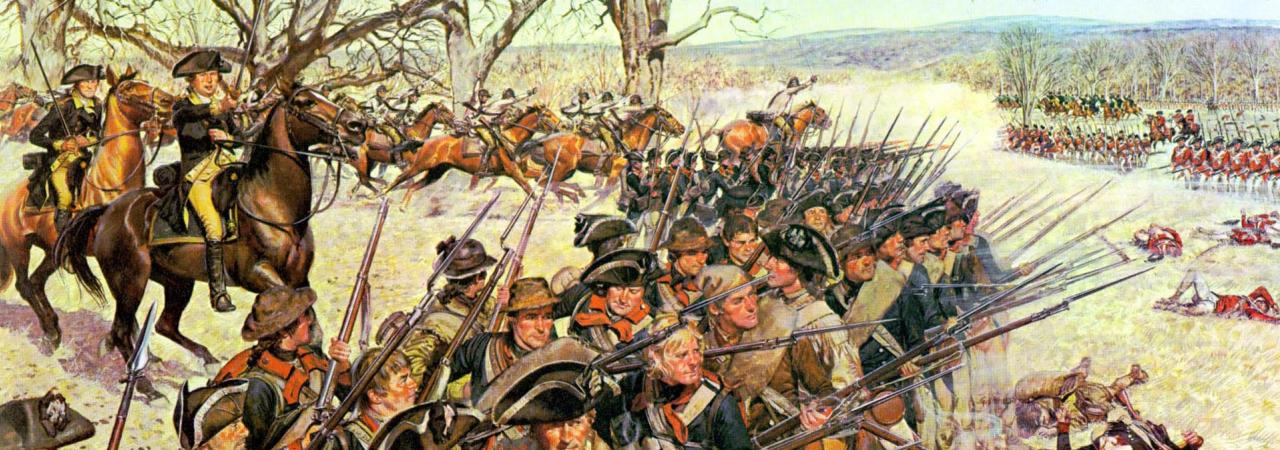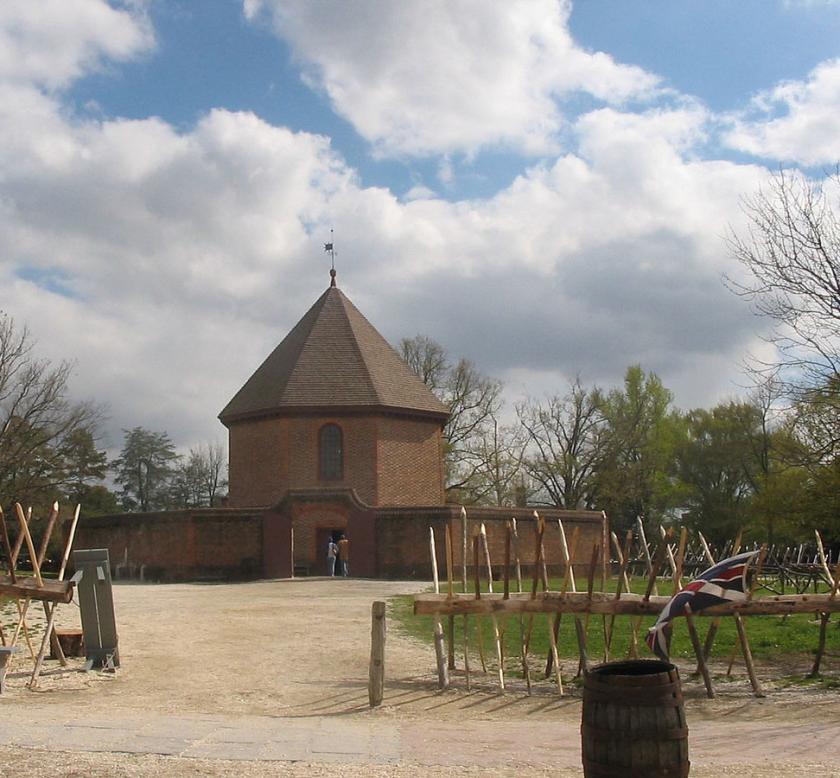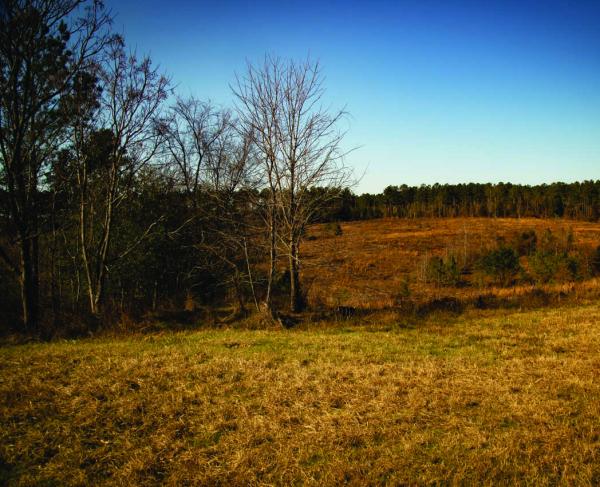
The 1st Maryland Line stands their ground at the Battle of Guilford Courthouse
The Southern Theater of the Revolutionary War is often reduced to the battles of Camden, Cowpens, Guilford Courthouse, and Yorktown. In fact, fighting in the Southern colonies raged through the entire war and was an area of great concern for both sides. In the final years of the war, following the fall of Charleston to the British in May 1780, the South became the principal theater of the Revolutionary War. In addition to regular fighting between the armies, a civil war erupted between Patriots and Loyalists, with many small battles between militias raging throughout the countryside.
In the South, the conflict began much as it did in the North, with British authorities attempting to disarm the growing Patriot militias. On April 20, 1775, a day after Lexington and Concord, the British Royal Governor of Virginia ordered British sailors to secure the store of gunpowder at Williamsburg. Patrick Henry led a small militia force to Williamsburg to recapture the gunpowder, but unlike Lexington and Concord, there was no fighting during this “Gunpowder Incident.” Instead, the British merely paid for the powder and both sides backed down.
Open conflict erupted on November 17, 1775, when British regulars skirmished with Patriot militia at the Battle of Kemp’s Landing in Virginia. In the South, where the split between Patriots and Loyalists was much more even, both militias recruited heavily. The years of 1775-1777 were dominated by small skirmishes and the British need for a deep-water port to support their southern campaign. In June 1776, British Major General Sir Henry Clinton and Commodore Sir Peter Parker attempted to capture Charleston, the most critical port in the South, but were unable to reduce Fort Sullivan (which would become Fort Moultrie, named for the commander who led the successful defense) and take the city.

The failures at Charleston made the British turn their attention to another deep-water port, Savannah, Georgia, which they captured on December 29, 1778. The fall of Savannah inaugurated the British “Southern Strategy,” the goal of which was subduing the southern colonies, where they felt there was more loyalist support, before turning north to crush the hotbed of the revolution. Early American victories in the Southern Theater came in February 1779, at Port Royal Island, South Carolina, when primarily militia forces under American Brigadier General William Moultrie defeated British regulars, and at Kettle Creek, Georgia, where Patriots under the command of Colonel Andrew Pickens defeated a Loyalist force twice its size.
In October 1779, an American army commanded by Major General Benjamin Lincoln, supported by the French fleet, attempted to recapture Savannah from the British. After besieging the city for a month, Lincoln was repulsed with heavy losses. This successful defense solidified the British hold on Savannah and enabled them to establish a base of operations in the South.
1780 marked major British campaigns to consolidate their gains and subjugate the lower South. In late December 1779, Sir Henry Clinton,with his force of nearly 14,000 , departed New York for Charleston, bent on capturing the city where he previously failed. On April 1, Clinton laid siege to the city and its 5,000 defenders under Lincoln. Because of British superior numbers and lack of fortifications, Lincoln surrendered his entire force on May 12. With the surrender, considered the worst American loss of the Revolutionary War, the American Continental southern army was shattered, and defense of the South fell largely to local militias commanded by Partisan leaders like Francis Marion (the “Swamp Fox”), Thomas Sumter (the “Gamecock”), and Andrew Pickens (the “Wizard Owl”).
The British maintained their momentum after the fall of Charleston by pursuing the last remaining Continental troops in the South. Forces under Colonel Banastre Tarleton caught Abraham Buford’s Continentals at Waxhaws on May 29, 1780, where Buford’s forces were massacred despite their efforts to surrender, earning Tarleton his infamous reputation for “Tarleton’s Quarter.”

In June 1780, Clinton handed over command of the Southern Theater to Charles Lord Cornwallis and departed for New York, but not before issuing a fateful proclamation requiring all Patriots paroled after the fall of Charleston to take an oath of allegiance to the Crown. With the American losses at Charleston and Waxhaws, the British were on the verge of controlling the southern colonies. However, the Waxhaw massacre, together with General Clinton’s ill-received proclamation, inspired many patriots in the area, and fresh militiamen eagerly joined the American cause. These new recruits contributed to many inspiring patriot victories in the South Carolina backcountry throughout 1780 and 1781, including Williamson’s Plantation (or Huck’s Defeat), Hanging Rock and Rocky Mount.
While this bloody civil war was unfolding in the backcountry of South Carolina, Horatio Gates, “the Hero of Saratoga,” was sent South to command a new Continental army to replace the one surrender at Charleston. Upon hearing of Gates’ new Southern Continental army, Cornwallis marched inland from Charleston to reinforce the key British post at Camden and on August 16, 1780, collided with Gates just north of Camden. The resulting battle was a bloody defeat for the Americans, and Gates, utterly defeated, fled. The remnants of this second Continental army in the South withdrew to North Carolina, where they would remain for several months awaiting a new commander to replace Gates.
With American resistance in the South faltering, a victory was desperately needed to slow British gains. As Cornwallis prepared to march into North Carolina, he sent Major Patrick Ferguson and his Loyalist militia to sweep through western South Carolina and gather forces, with the ultimate goal of rejoining Cornwallis in North Carolina. To stop them, frontiersmen primarily from Tennessee, Virginia and North Carolinas, rugged “Overmountain Men,” tracked and ambushed Ferguson’s force atop Kings Mountain on October 7, 1780. In retaliation for Waxhaws, the Americans gave the British Loyalists no quarter. The Patriot victory at Kings Mountain would prove to be a major turning point in the war in the South. Ferguson was killed and his force decimated. Forced to abandon the North Carolina campaign, Cornwallis returned to South Carolina for the winter.

The American cause was further bolstered in December 1780 with the arrival of Nathanael Greene, one of Washington’s most trusted generals, to command the Continental Army in the South. In late 1780, Cornwallis detached part of his force under Tarleton to continue to hamper patriot activities in the Carolinas. Greene sent one of his own favored commanders, Daniel Morgan, to counter Tarleton. The two detachments met on January 17, 1781 at the Battle of Cowpens, near the North and South Carolina border, where Morgan’s superb tactical abilities soundly defeated Tarleton.
While Cowpens was a setback, the British were far from defeated. From January to March 1781, Greene and Cornwallis fought a war of skirmish and maneuver, with Greene steadily withdrawing farther into North Carolina. This phase, known as the “Race to the Dan,” the Dan River being a crucial water barrier in the region, helped wear down Cornwallis’ army, and separate the British from their supply lines. The Race culminated at Guilford Courthouse, where Cornwallis was able to drive the Americans from the field, but with heavy casualties: a classic Pyrrhic victory
Unable to trap and destroy Greene, Cornwallis decided to invade Virginia, still untouched by the war, and cut American supplies to the Carolinas. Cornwallis’ initial actions in Virginia were successful; American forces under Lafayette were able to slow, but not stop, Cornwallis’ campaign.
Meanwhile, Greene returned to the Carolinas. The armies met again outside Camden, at the Battle of Hobkirk’s Hill on April 25, 1781, where the British won the field, but withdrew to Charleston. Afterwards, Greene besieged the British garrison at Ninety Six, but the British were able to lift the siege with reinforcements from Charleston.
Despite the victory at Ninety Six, the efforts of Greene and patriot militia leaders forced the British to withdraw. Greene attacked the British again at Eutaw Springs on September 8, 1781, where despite retreating, Greene inflicted enough casualties to compel the British to withdraw toward Charleston. With American forces under Lieutenant Colonel Henry “Light Horse Harry" Lee driving the British back to Savannah, and Greene pinning the British in Charleston, the patriots were rapidly solidifying control of Georgia and South Carolina.

Concurrently, Cornwallis had established a base of operations at Yorktown, hoping for resupply and reinforcement by sea. The French victory at the Battle of the Capes on September 5, 1781, removed this possibility, and cut off Cornwallis by sea. With the arrival of American and French troops, the encirclement was complete, and the siege began on September 28, 1781. After nearly a month, Cornwallis was forced to surrender. When news of the surrender reached British Prime Minister Lord North he exclaimed, “Oh God, it’s all over.”
While the war continued until the Treaty of Paris in 1783, Yorktown marked the collapse of the British war efforts. The British “Southern Strategy,” while initially promising, had ended in utter failure. The fight for independence in the Southern Colonies was long, bloody and brutal but ultimately paved the way for American victory.
Related Battles
1,900
324
5,506
258
149
868
579
882
1
102
1,310
532
270
258
21
115
90
1,018
16
133
147
85
30
52
948
155
316
17
389
8,589


